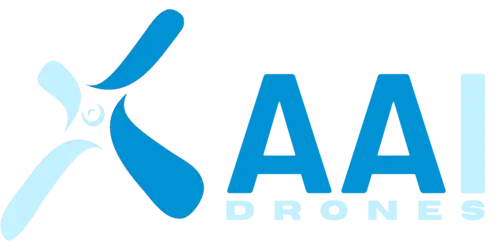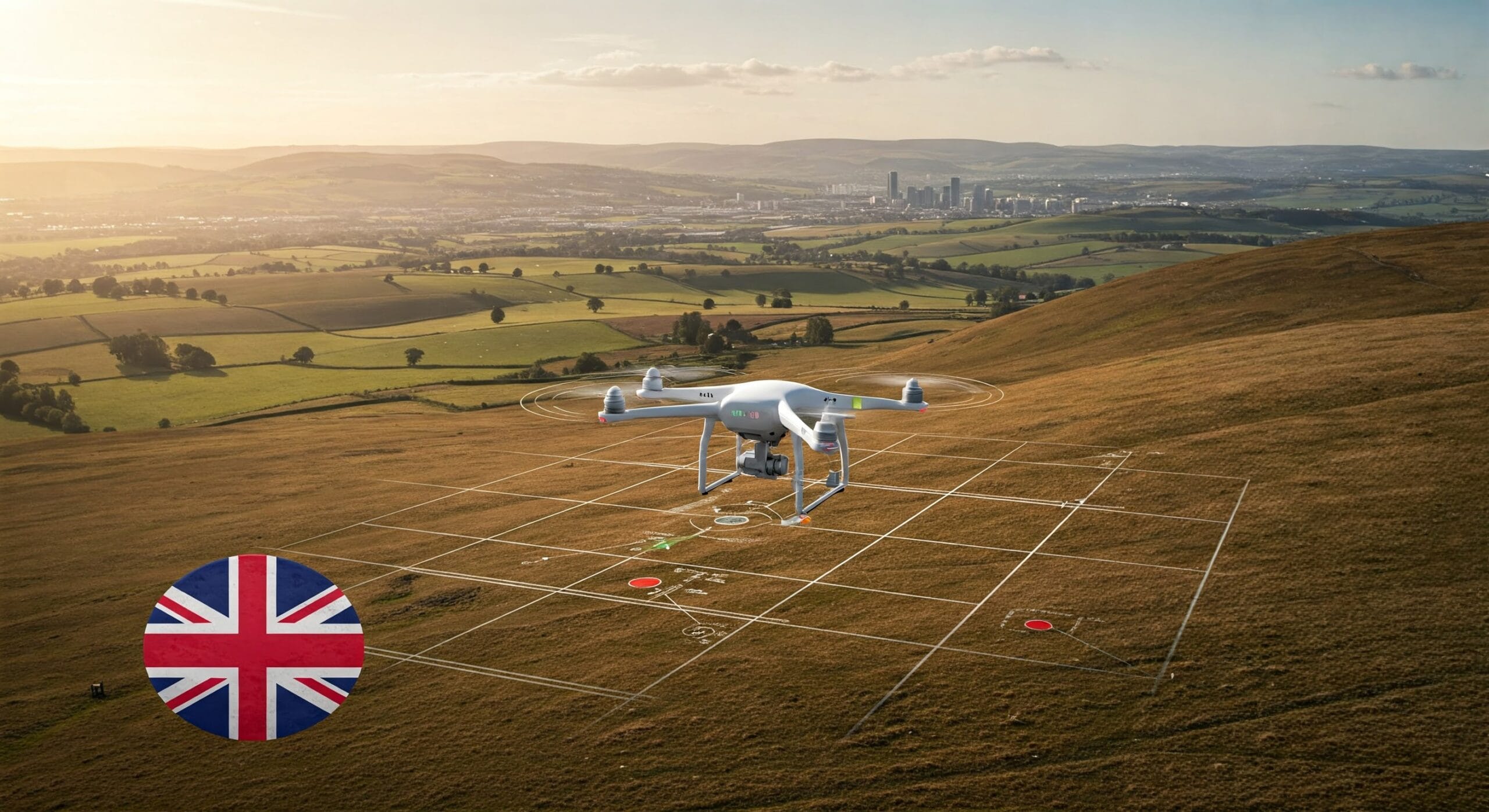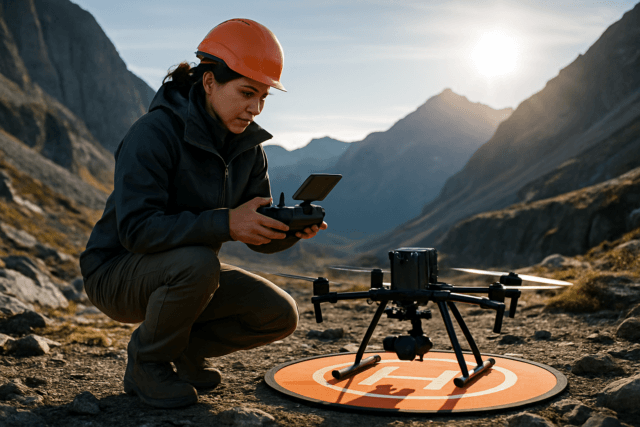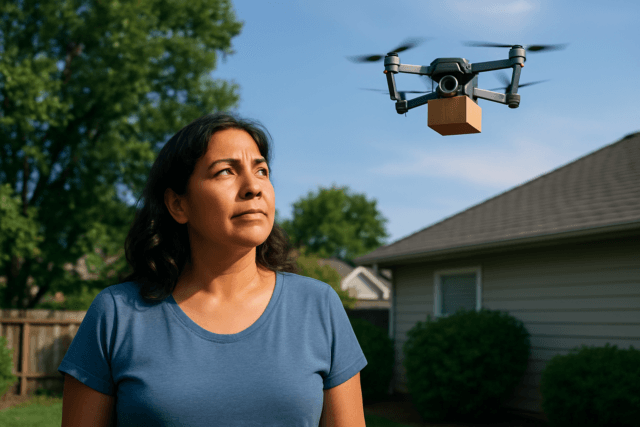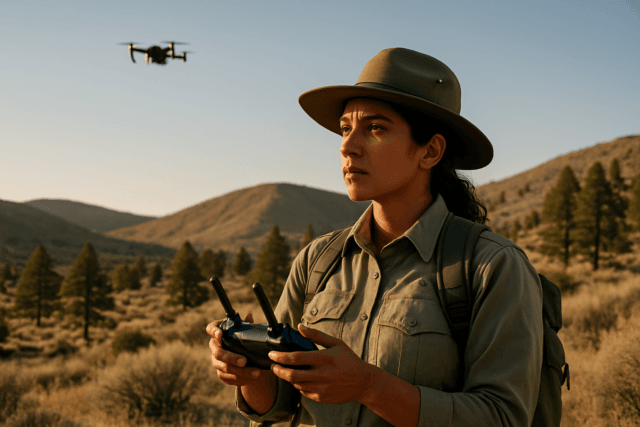The landscape of drone operations in the United Kingdom is undergoing a significant transformation with the impending implementation of the Specific Operations Risk Assessment (SORA) methodology. This new framework, spearheaded by the UK Civil Aviation Authority (CAA), marks a pivotal shift in how drone operations beyond the low-risk “Open” category will be evaluated and authorized. Set to become effective on April 23, 2025, the UK SORA aims to provide a more structured, internationally aligned, and quantifiable approach to assessing and mitigating the risks associated with increasingly complex drone activities 1. This report delves into the intricacies of the UK SORA, exploring its purpose, key components, implications for drone operators, the role of assessment entities, timelines for implementation, associated costs, and the anticipated benefits of this new regulatory era.
Introducing the UK Specific Operations Risk Assessment (SORA)
The Specific Operations Risk Assessment (SORA) is a methodology meticulously crafted to classify the inherent risks associated with a particular Unmanned Aircraft System (UAS) operation 4. Its fundamental purpose lies in the identification of appropriate mitigations and the establishment of clear safety objectives to effectively counter these identified risks 4. By employing SORA, drone operators gain a structured framework to define the operational limitations of their flights, determine the necessary training objectives for all involved personnel, specify the technical requirements for the aircraft being used, and develop comprehensive operational procedures to ensure safety and compliance 4. This represents a move towards a more standardized and systematic evaluation of risk, potentially leading to greater consistency in regulatory outcomes compared to previous methods.
The decision by the UK to transition to the SORA methodology is driven by several key factors. Primarily, it is anticipated to enhance the overall experience for drone operators by fostering more consistent and predictable outcomes in the authorization process 3. Furthermore, SORA is designed to facilitate the approval of higher-risk and more innovative drone operations, which may have faced greater hurdles under previous regulatory frameworks 3. This shift also reflects a broader trend towards international harmonization within the drone industry, as SORA has been developed with the consensus of numerous National Aviation Authorities (NAAs) and industry experts globally 4. This international collaboration suggests a move towards greater interoperability and mutual recognition of drone operations across different jurisdictions in the future.
In the context of UK law, the UK SORA will function as an Acceptable Means of Compliance (AMC) to Article 11 of Regulation (EU) No 2019/947, which has been retained and amended within UK domestic law following the European Union (Withdrawal Act 2018) 4. It is crucial to understand that SORA itself is not a legally binding regulation but rather a set of recommendations and guidelines intended to aid in conducting a thorough risk assessment and achieving the required target levels of safety 4. The adoption of SORA as an AMC is a strategic move by the CAA, allowing for the implementation of a new, internationally recognized framework without necessitating the creation of entirely new primary legislation. This approach offers a more agile and adaptable pathway for updating drone regulations in response to technological advancements and evolving operational needs.
The Foundation: UK SORA and its International Context
At the heart of the UK SORA lies the framework developed by the Joint Authorities for Rulemaking on Unmanned Systems (JARUS) 5. JARUS, a consortium of global aviation authorities, created SORA to establish a standardized methodology for the assessment and mitigation of risks associated with drone operations falling within the Specific Category 5. The UK’s approach involves developing its own version of SORA in close alignment with the JARUS framework 5. Specifically, the UK CAA intends to implement a UK-specific adaptation of JARUS SORA version 2.5 6. This alignment underscores the UK’s commitment to adopting internationally recognized best practices in the realm of drone safety and regulation, which could foster greater trust and potentially simplify operations for businesses operating across international borders.
While the UK SORA is heavily influenced by the JARUS framework, there will be certain distinctions to accommodate the unique national requirements and airspace regulations within the United Kingdom 2. These specific differences are expected to be detailed within the UK SORA consultation documents 5. The UK adaptation of JARUS SORA v2.5 is specifically designed to align with the intricacies of UK airspace management 2. This necessary customization ensures that the framework effectively addresses the specific operational environment and regulatory context of the UK.
A significant shift embodied by the SORA methodology is the move from a primarily qualitative approach to risk assessment, as seen in the previous CAP 722A guidelines, towards a more quantitative methodology 4. This transition suggests a desire for a more objective and data-driven evaluation of risks associated with drone operations. A quantitative approach typically involves the use of numerical data and metrics to assess the likelihood and severity of potential hazards, which could lead to more precise safety measures and potentially more efficient and evidence-based decision-making in the authorization process.
Key Components and Principles of the UK SORA Methodology
The UK SORA methodology is built upon the fundamental principle of classifying and mitigating both ground and air risks inherent in drone operations 2. This comprehensive approach recognizes that drone flights can pose risks not only to people and property on the ground but also to other airspace users 6. The methodology provides a structured framework to assess these dual risks, ensuring that operators consider all potential safety implications of their intended operations 4.
A core element of the UK SORA is the definition of Operational Safety Objectives (OSOs) and specific containment requirements 2. These OSOs, detailed in Annexes B and E of the UK SORA documentation, provide clear and measurable targets for operators to achieve in order to demonstrate the safety of their operations. An example includes OSO 2, which focuses on the mitigation of technical issues. Furthermore, the methodology outlines containment requirements to ensure that if an incident occurs, the drone remains within a defined area, minimizing potential harm to third parties 2. To demonstrate compliance with these OSOs, operators are required to document their approach in a ‘compliance matrix,’ a structured document that specifies each requirement, the method of compliance, and the evidence supporting that claim, such as flight logs or technical data sheets 2. The introduction of specific and documented safety objectives enhances accountability and allows for more effective regulatory oversight.
The concept of Specific Assurance and Integrity Levels (SAILs) is central to the UK SORA methodology 2. UK SORA assigns a SAIL ranging from 1, representing the lowest risk, to 6, indicating the highest level of risk 2. The determined SAIL for a particular operation directly influences the required robustness of the mitigation measures that an operator must implement. These measures encompass various aspects, including the design and construction of the UAS, its operational characteristics, and the procedures employed during flight 2. SAIL serves as a crucial indicator of the overall risk level associated with a drone operation and dictates the stringency of the corresponding safety and regulatory requirements needed to mitigate that risk 3. This tiered system allows for a more proportionate regulatory response, ensuring that lower-risk operations are not unduly burdened with overly complex requirements while higher-risk activities are subject to more rigorous scrutiny.
Implications for Drone Operators: Navigating the New Regulatory Landscape
Understanding the different SAIL levels, ranging from I to VI, is paramount for drone operators as each level carries distinct operational requirements 3. SAIL I represents very low-risk operations, such as flights with small drones in remote areas with minimal exposure to people or critical infrastructure 3. As the SAIL level increases, so do the complexity and potential risks of the operations. SAIL II involves low-risk operations that still necessitate certain safety measures, while SAIL III encompasses moderate-risk operations, potentially conducted over controlled ground environments 3. The higher SAIL levels (IV, V, and VI) typically correspond to more complex and higher-risk scenarios. Drone operators will need to meticulously assess the risk profile of their intended operations to accurately determine the applicable SAIL level. This determination will then dictate the specific safety measures, technical requirements, and potentially the application fees associated with their operational authorization.
The UK SORA methodology also has significant implications for Beyond Visual Line of Sight (BVLOS) operations conducted in non-segregated airspace 4. While SORA is recognized as a valuable tool that can enable such advanced operations, it is not intended as an automatic gateway for full integration of all types of UAS into every class of airspace 4. Rather, SORA provides a framework to indicate the necessary performance goals for airspace segregation or integration measures required to meet the target levels of safety for a given airspace volume 4. This suggests that while SORA offers a pathway for more complex BVLOS flights, operators will need to conduct a thorough risk assessment and demonstrate the implementation of robust safety measures to gain approval. It underscores that BVLOS authorization will be contingent on a comprehensive safety case rather than a simple procedural step.
Pre-defined Risk Assessments (PDRAs) also play a role within the UK SORA framework 4. The UK CAA is currently reviewing the existing PDRA package developed by JARUS, and if deemed acceptable, these pre-assessed risk profiles will be adopted within the UK regulatory system 4. For operators who currently hold PDRA-01 authorizations, the immediate impact of SORA may be limited as their operational authorization is already pre-defined 6. However, for other types of operations, the adoption of JARUS-developed PDRAs could potentially streamline the approval process for certain common and well-understood drone activities. This would allow operators engaging in these specific types of flights to potentially avoid the need for a completely bespoke risk assessment, provided their operation aligns with the parameters of the pre-defined scenario. The fees associated with PDRA applications under the SORA framework are outlined in the CAA’s Scheme of Charges 3.
| SAIL Level | Risk Level | Typical Operational Scenarios | Key Regulatory Considerations | Initial Application Fee |
| I | Very Low | Small drones in remote areas, minimal exposure to people/infrastructure | Minimal specific requirements beyond general safety regulations | £2,185 |
| II | Low | Operations requiring some safety measures | Specific safety protocols and potential limitations | £3,495 |
| III | Moderate | Operations over controlled ground environments | More stringent safety measures, potentially involving ground coordination | £13,759 |
| IV | Moderate to High | Operations with increased complexity and potential impact | Significant safety protocols, robust contingency plans required | £13,759 |
| V | High | Complex operations in potentially populated or sensitive areas | Extensive safety justifications, advanced technical requirements | £39,967 |
| VI | Very High | Highly complex or high-risk operations | Extremely rigorous safety case, potentially bespoke approvals | £39,967 |
Note: Fees are based on initial application and may be subject to change. Refer to the latest CAA Scheme of Charges for the most up-to-date information.
The Role of Recognised Assessment Entities (RAEs) in UK SORA
Recognised Assessment Entities (RAEs) will play a critical role in the implementation and oversight of the UK SORA framework. Specifically, there will be two primary types of RAEs: RAE(F) focusing on Flightworthiness and RAE(PC) responsible for Remote Pilot Competence 2. The CAA has published documents CAP722J and CAP722K, which detail the technical assessments to be conducted by RAE(F)s 2. These entities will be responsible for evaluating the airworthiness of UAS intended for operations under SORA. Simultaneously, CAP722B has been updated to outline the requirements for entities seeking to become RAE(PC)s, who will manage the assessment and certification of remote pilot competency under the new framework 1. This division of responsibilities underscores the importance of both the technical integrity of the drone and the proficiency of the pilot in ensuring safe operations.
Drone manufacturers will have the option to seek a SAIL Mark certificate for their UAS 2. This certificate, verified by an RAE(F) and issued by the CAA, confirms that the drone design and construction meet the UK SORA requirements for a specific SAIL level 2. The policy governing SAIL Marks is detailed in CAP 722K 2. Obtaining a SAIL Mark offers a proactive way for manufacturers to demonstrate the inherent safety and compliance of their aircraft, which can significantly streamline the process for operators using such certified equipment when applying for operational authorizations.
For operators whose UAS does not possess a SAIL Mark, a flightworthiness assessment conducted by an RAE(F) will be a necessary part of the Operational Authorisation (OA) process 2. In these cases, the RAE(F) will evaluate the specific UAS intended for the operation and produce a flightworthiness report confirming its suitability for the proposed activities 2. Flightworthiness, in this context, is defined as the technical assurance that the UAS can be operated safely 2. This requirement ensures that all drones operating under the Specific Category meet the requisite safety standards, regardless of whether they have undergone a pre-market certification process.
Pilot competency standards are also intrinsically linked to the SAIL levels defined within the UK SORA framework 2. The training and assessment of remote pilots will be managed by RAE(PC)s in accordance with CAP 722B 2. These entities will issue Remote Pilot Certificates (RPCs) with levels ranging from L1 to L4, with higher levels indicating greater competency for more complex operations 2. The CAA has introduced expanded Acceptable Means of Compliance (AMC) for remote pilot competence to support enhanced training and progression for pilots undertaking increasingly complex UAS operations 1. This tiered system of pilot certification ensures that pilots possess the necessary skills and knowledge commensurate with the risk level of the operations they intend to conduct, thereby contributing to overall flight safety.
Timelines, Application Process, and Associated Costs
The UK SORA methodology is scheduled to become effective on April 23, 2025 1. Coinciding with this date, the CAA will launch its new digital UK SORA Application Service, through which operators will be able to apply for SORA-based Operational Authorisations 2. This clear timeline provides a crucial window for drone operators to familiarize themselves with the new requirements and prepare for the transition.
The introduction of the digital UK SORA Application Service is a key component of the CAA’s Digitising Specific Category Operations (DSCO) project 3. This online platform aims to modernize and streamline the process of applying for and obtaining operational authorizations under the Specific Category. By digitizing the application process, the CAA anticipates enhancing both the safety assurance and the overall efficiency of the authorization process for drone operators 3.
The application process for SORA-based Operational Authorisations will likely involve a more structured approach, with operators required to document their compliance with the relevant OSOs in a ‘compliance matrix’ 2. While the specifics of the application process may differ from the current system used for flights in the Specific Category, the digital platform is expected to guide operators through the necessary steps. The launch of this platform on April 23, 2025, marks a significant shift towards a more digital and potentially more transparent application experience.
It is important for drone operators to be aware of the costs associated with the new UK SORA methodology. The fees for SORA applications are generally higher compared to the previous Operating Safety Case (OSC) framework 3. The CAA’s Scheme of Charges for 2025/26 provides a detailed breakdown of these costs, which vary depending on the SAIL level of the operation and whether the application is for a Pre-Defined Risk Assessment (PDRA) or a specific SORA assessment 3. For instance, a declarative PDRA application costs £500 for both initial application and renewal, while a non-declarative PDRA application is priced at £2,185 for both 3. SORA application fees range from £2,185 for SAIL I to £3,495 for SAIL II, and significantly higher for SAIL III/IV (£13,759 initial, £8,816 renewal) and SAIL V/VI (£39,967 initial, £13,420 renewal) 3. Additionally, applications for SAIL II and above may be subject to excess hourly charges 3. These increased costs, particularly for higher-risk operations, represent a significant financial consideration for drone operators and businesses in the sector.
Benefits and Advantages of the UK SORA Methodology
Despite the increased costs, the UK SORA methodology offers several potential benefits and advantages for the drone industry. The CAA emphasizes that the new framework is designed to enhance safety assurance and lead to more consistent and predictable regulatory outcomes for operators 3. By establishing clear target levels of safety and a structured approach to risk assessment, SORA aims to create a more transparent and reliable authorization process 4.
Furthermore, SORA is specifically intended to facilitate the approval of higher-risk and more innovative drone operations that may have previously faced significant regulatory hurdles 3. Its potential to enable BVLOS flights in non-segregated airspace opens up new possibilities for a wider range of commercial applications, fostering innovation and growth within the drone industry 4. This could unlock opportunities for more efficient infrastructure inspection, enhanced surveillance capabilities, and the development of new drone-based services.
The UK’s adoption of the SORA methodology also signifies an alignment with international standards in UAS regulation 2. As SORA has been developed through international consensus among various National Aviation Authorities and industry experts, its implementation in the UK brings the national regulatory framework closer to global best practices 4. This alignment can potentially foster greater interoperability and mutual recognition of drone operations and pilot qualifications across different countries, which could be particularly beneficial for businesses operating internationally.
Transitioning from Existing Frameworks to UK SORA
The implementation of UK SORA will necessitate a transition for drone operators who currently hold Operational Safety Cases (OSCs) under the previous CAP 722A framework 2. Existing OSCs will need to be revised to align with the new SORA methodology 5. The CAA has indicated that there will be a transitional period to allow operators sufficient time to undertake this revision process 5. This transition will likely involve operators incurring expenses related to engaging with RAEs for new assessments, potentially requiring pilot retraining to meet the updated competency standards, and updating their operational documentation to comply with the SORA requirements 2.
The specifics of this transitional period, including the exact timelines and requirements for OSC revision, were expected to be detailed as part of the consultation process for the UK SORA 5. It is anticipated that the current application process for flights in the Specific Category will undergo changes to reflect the new SORA framework 5. Providing clear guidance and a reasonable timeframe for this transition will be crucial to ensure a smooth adoption of the UK SORA methodology by existing drone operators and to minimize disruption to their operations.
| Feature/Aspect | CAP 722A (OSC) | UK SORA | Benefit of the Change |
| Risk Assessment Approach | Primarily Qualitative | More Quantitative | More objective and data-driven risk evaluation, potentially leading to more precise safety measures. |
| Focus | Case-by-case assessment, potentially less standardized | Structured methodology with defined risk levels (SAILs) | Greater consistency and predictability in the authorization process. |
| International Alignment | Less directly aligned with international standards | Developed based on JARUS SORA, an international standard | Facilitates interoperability and potential mutual recognition of operations. |
| Safety Objectives | Less formally defined in some cases | Explicit Operational Safety Objectives (OSOs) | Provides clear and measurable targets for safety and enhances regulatory oversight. |
Conclusion: Preparing for the Future of UK Drone Operations with SORA
The introduction of the UK Specific Operations Risk Assessment (SORA) marks a significant evolution in the regulation of drone operations within the United Kingdom. This new framework brings a more structured, quantitative, and internationally harmonized approach to the evaluation of risks associated with drone flights beyond the Open category. While the implementation of SORA introduces new requirements and potentially higher costs for drone operators, it also offers the promise of enhanced safety assurance, more consistent regulatory outcomes, and the facilitation of more complex and innovative drone operations.
As the effective date of April 23, 2025, approaches, it is crucial for drone operators to proactively prepare for these changes. Understanding the different SAIL levels, the pivotal role of Recognised Assessment Entities (RAEs), and the intricacies of the new digital application process will be essential for navigating the evolving regulatory landscape. Operators currently holding OSCs should begin to familiarize themselves with the SORA methodology and the anticipated requirements for revising their operational authorizations. By embracing this new framework and diligently preparing for its implementation, the UK drone industry can look forward to a future where innovation and safety go hand in hand, unlocking the full potential of unmanned aircraft systems within a well-defined and internationally recognized regulatory environment.
Works cited
- CAA give update on SORA & CAP722B Remote Pilot Competence., accessed on March 20, 2025, https://www.arpas.uk/cap-722b-ed-5-uk-sora-remote-pilot-competency-amc-gm-announced-by-caa/
- ORS9 CAA SORA Decision No. 46: A Structured Framework for UAS …, accessed on March 20, 2025, https://www.drone-docs.co.uk/post/ors9-caa-sora-decision-no-46-a-framework-for-uas-regulation-with-significant-cost-implicatio
- UK CAA releases 2025/26 Scheme of Charges for drone operators, accessed on March 20, 2025, https://www.heliguy.com/blogs/posts/uk-caa-scheme-of-charges-25-26-for-drone-operators/
- Specific Operations Risk Assessment (SORA) Update | UK Civil …, accessed on March 20, 2025, https://www.caa.co.uk/drones/rules-and-categories-of-drone-flying/specific-operations-risk-assessment-sora-update/
- UK Specific Operations Risk Assessment (SORA) | UK Civil Aviation …, accessed on March 20, 2025, https://www.caa.co.uk/drones/digitising-specific-category-operations-disco-project/uk-specific-operations-risk-assessment-sora/
- SORA methodology – ARPAS UK, accessed on March 20, 2025, https://www.arpas.uk/tag/sora-methodology/
